CPACS Ride - Lessons Learned in Four Phases - Phase 4: Planning & Implementation
30 minutes Author: Shared-Use Mobility Center Date Launched/Enacted: Aug 2, 2022 Date Published: August 2, 2022
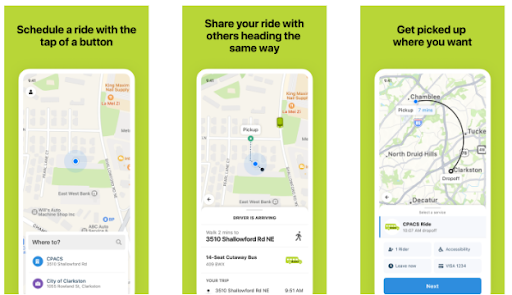
Brief Summary:
- The Center for Pan Asian Community Services (CPACS) received a grant from the Community Transportation Association of America (CTAA) in 2020 to provide mobility on demand (MOD) solutions for people with disabilities and older adults, through a service called CPACS Ride.
- The Project Team is working together to integrate a booking and routing app for riders and the dispatch team.
- As of July 2022, the software is being used by drivers and the dispatch team. From their feedback, the settings are changing to yield optimal results.
- The next steps include a usability study and going live with riders.
Introduction
This is the fourth and last phase of the lessons learned module on the Center for Pan Asian Community Services (CPACS) Ride microtransit service. The first phase was on learning and building trust, the second phase was on procurement, and the third explored the benefits and challenges of coordinating rider trips between two agencies. The project’s fourth phase involves planning, implementing, and optimizing the procured trip scheduling and on-demand technology platform.
Project Background
The Center for Pan Asian Community Services, Inc. (CPACS) is a nonprofit organization located in Chamblee, GA, a first-ring suburb of Atlanta. Established as the first and largest Asian American and Pacific Islander community-based organization in the Southeast region, CPACS provides its core group of services to immigrant and refugee families throughout the Metro Atlanta region. Its mission is to promote self-sufficiency and equity for immigrants, refugees, and the underprivileged through comprehensive health and social services, capacity building, and advocacy. Since 2012, CPACS has provided culturally competent paratransit and employment transportation services throughout DeKalb and Gwinnett counties. The addition of FTA-funded transportation programs has helped CPACS overcome geographic limitations to serve nearly 70,000 clients annually.

Figure 1 – An aerial view of the city of Clarkston in Georgia. Credit: Google Maps
The City of Clarkston is one of the main communities that CPACS serves. About 15,000 people are living in Clarkston with around 5% aged 65 and older and 6% persons with disabilities under the age of 65. Clarkston’s median income is $40,105 and its poverty rate is 31%. Clarkston is an ethnically diverse community composed of 60% African-American and 26% Asian residents, with 53% of residents being immigrants (U.S. Census Bureau, 2020). Major communities in Clarkston include Burmese, Bhutanese, Chinese, Korean, and East African. These communities primarily live in moderate-density subdivisions surrounded by low-density arterial roadways. Figure 1 illustrates the City of Clarkston’s border and the suburban nature of the built environment. The suburban nature of Clarkston makes travel without a personal vehicle difficult and underscores the important mobility options that CPACS provides.
CPACS Transportation provides a variety of demand-response trip types such as reverse commute trips, scheduled quality of life group trips such as to the grocery store, non-emergency medical trips, and trips to pick up seniors to attend CPACS senior programs throughout the week. For many CPACS riders, this remains their primary means of transportation.
Project Team
This project was funded by the Administration for Community Living (ACL) and administered by Community Transportation Association of America (CTAA). The project team included:
- Atlanta Regional Commission (ARC) – Project lead with a focus on convening, procurement and regional replicability
- Center for Pan Asian Community Services (CPACS) – Community-based nonprofit organization that plans to improve its transportation services through the community lead implementation of the demand-response transit and transactional data specification
- Gwinnett County Transit (GCT) – Gwinnett County Transit neighbors Clarkston and explored trip sharing opportunities with CPACS
- Shared-Use Mobility Center (SUMC) – Lead consultant providing technical guidance on planning and implementation
- Atlanta Region Transit Link Authority (ATL) – Regional government focused on helping the project consider regional connections and improving the rider experience
Planning
The project team took several steps to plan for the launch of the scheduling and dispatching software and mobile booking app to help streamline the new on-demand service, CPACS Ride.
To start, the project team wanted to build a strong relationship and foundation with the project team, which consisted of several external partners. We dedicated the first few months of the project to building trust within the project team and learning about CPACS mobility services. For more information on that process, you can read our module on building trust.
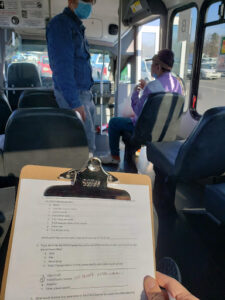
Figure 2: Surveying on a CPACS Ride Shuttle
Once we had a solid team base, we began to work with the community. For most community members, English is not their native language and many are older adults or persons with disabilities. Our community engagement efforts required much more time to ensure that each encounter was translated, understandable, and meaningful. Due to the COVID-19 pandemic, we had to rely on Zoom meetings, so we held 1:1 tutorials and developed a manual on how to use Zoom for community members that were not comfortable with technology. Because of this, we could host meaningful conversations and connect with community members safely. For example, this photo shows one of the meetings we held on three different shuttles. Each shuttle had a translator and a small group of riders to maintain a safe social distance.
While these meetings were valuable, we had to move on to the procurement phase of the project to keep up with the project schedule. For future projects, allotting a longer time to focus on a community-led needs assessment would benefit its inclusivity and understanding of the community’s needs. A needs assessment is a process to understand residents’ current travel behavior, identify their transportation needs and challenges, and identify potential new mobility options. This process can take the form of surveys, focus groups, site visits, analyses of current mobility options, current ridership origin, and destinations, and more. When a needs assessment is community-led, residents are empowered to shape the outcomes in their community. Community engagement is a part of the larger needs assessment process and this project involved several factors that made community engagement a more deliberate process.
One of the significant components of community engagement that was unique to this project was the ability to rely on existing relationships and the deep trust built over time between CPACS and the communities being served. The project team was able to gain invaluable insight and feedback through engagements that centered around 1:1 interactions between CPACS Transportation riders, operators, Mobility Coordinators, or directly through Frank Lee, Director of Transportation at CPACS. For CPACS, these 1:1 interactions hold a lot of weight on the scale of inclusive planning. Typical planning and community engagement exercises often overlook cultural differences and are not centered on culturally competent methods. These engagement activities void of cultural competency deter meaningful engagement with immigrant communities that are oftentimes uncomfortable sharing their true opinions and ideas in group settings in the presence of unfamiliar facilitators and notetakers. Additionally, CPACS provides many services beyond transportation. Many community members rely on CPACS staff and social services to confide in and help them navigate new places, processes, and systems in their native language.
To maintain the existing customer experience through CPACS Ride, we found that drivers who speak the same language and are able to provide culturally competent services to their own communities is not just a matter of convenience, but a necessity in providing transportation service for immigrant communities. Even before being hired, drivers often fill leadership roles in their own communities. Involving the drivers was critical to knowing what was happening on the ground. The project team created mechanisms to collect and track these informal conversations and qualitative data, however, time constraints limited drivers or CPACS staff from reporting on driver insights on a consistent basis. Collecting and reporting on this qualitative data is a component of this project that the team continues to work on.In order to understand CPACS riders’ needs and to empathize with CPACS riders, the project team created three personas that represent the diversity of CPACS’ ridership. Personas are a common tool used in UX Design, in which there are fictional characters that have their own goals, needs, and frustrations surrounding a specific topic. The project team can then reference these personas throughout a project to ensure that the design solutions will meet the end user’s needs and provide a good user experience.
We identified three different types of CPACS riders. The personas included:
- An older adult who relies on CPACS to complete her quality of life trips
- A young couple with a young adult son with disabilities
- A middle-aged person who relies on public transportation to commute to work
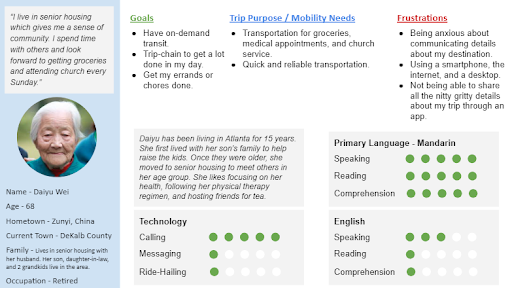
Figure 3 – An example of a CPACS Ride persona developed to help the project team learn about their goals, trip purpose:mobility needs, and frustrations. Credit- Shared-Use Mobility Center
From the persona activity, we learned that the app would need to be compatible in different languages such as Korean, Mandarin, and Swahili to support non-English speaking riders, who make up a majority of CPACS’ ridership. We also learned and created tutorials for riders to download and use the app. These personas then helped the team draft an Eligibility Decision Tree with several criteria levels so CPACS could more easily identify the riders with the greatest needs. CPACS met with riders that matched these persona types to understand if the project team’s perceptions matched rider sentiments.
In addition to creating user personas, we established user statements with CPACS’ staff to understand their challenges, needs, and wants. Specifically, this exercise allowed CPACS staff to express what their long-term and lofty goals were for the organization. We met with leaders across the organization including the CEO and others like a Victim Services Manager to align CPACS Ride with the rest of the organization. Themes of safety, opportunity and access were shared across all departments and levels.
While conducting the user persona exercises, the project team outlined all of CPACS’ transportation trips on a Miro Board, a collaborative online whiteboard. We tagged each trip to be able to see, at a glance, what type of trip it was and who it served. We used tags to indicate the community group the rider belongs to, if it was a group trip, whether the rider owns a car, has a severe medical condition, is low-income, lives alone, is a person with a disability, or is an older adult. These tags helped the project team understand the priority levels of each trip and how on-demand service can be incorporated into CPACS Ride’s already busy schedule. Through this exercise and the project team’s site visit, CPACS Ride carved out the resources to begin serving young adults with autism that needed a ride to Bennett’s Place, an after-school and summer program.
Implementation
On-demand service through CPACS Ride officially launched with scheduling and dispatching on the Spare platform in November 2021. All rides that CPACS provides are at no cost to the rider. Riders typically schedule trips in advance but same-day service and on-demand solutions are available pending driver availability. The service was live for about one month and then the team took time to revise and optimize the settings and workflow.
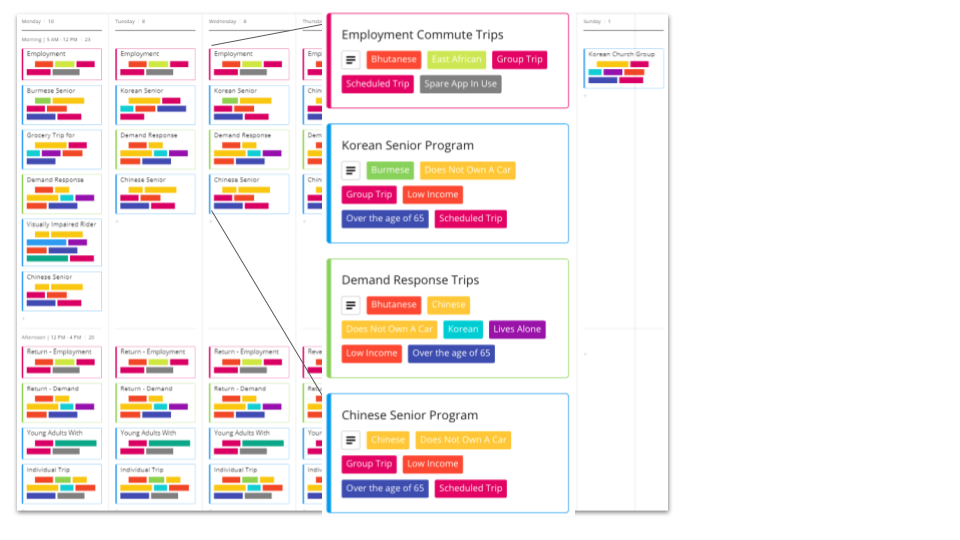
Figure 4 – Screenshot of the Miro Board project exercise that outlines CPACS’ transportation schedule. Credit: Shared-Use Mobility Center
The service was relaunched in March 2022. From March 1, 2022, to June 30, 2022, CPACS completed 2,595 trips and 2,758 boardings or number of riders transported. The average trip duration was 13.44 miles and 29 minutes. Many of CPACS trips were longer-distance rides, with an average long-distance trip of 25 miles or 42 minutes. The project is still working towards implementing the on-demand rider-facing app, although the app white labels have been created and the app has been translated into a number of languages to serve the community.
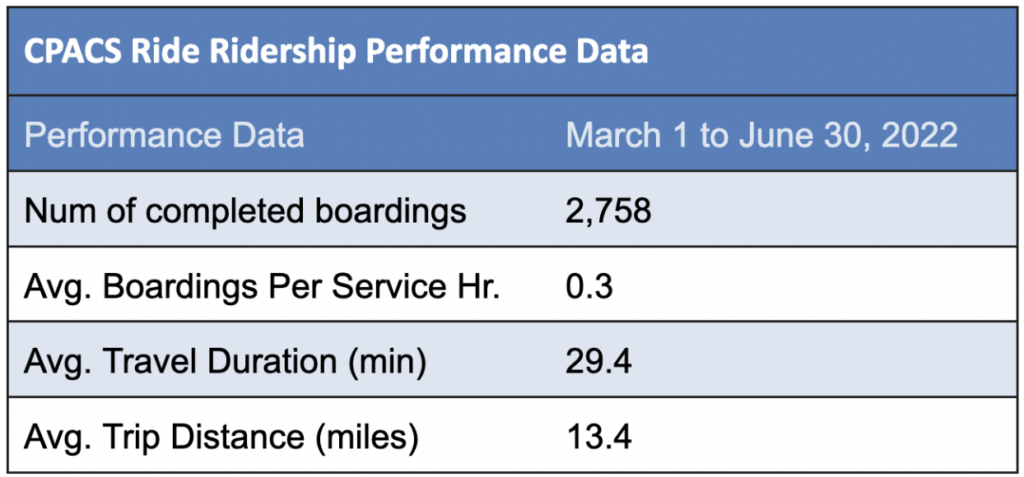
Figure 5 – A matrix summarizing CPACS Ride Ridership Performance Data. Credit: CPACS
CPACS currently operates with eight drivers and eight vehicles. Between March 1, 2022, and June 30, 2022, CPACS had a maximum of eight active vehicles at one time. Due to the driver shortages and supply chain issues, the CPACS transportation team has not had sufficient drivers or vehicles for the length of this project. In addition to general operational constraints and limitations caused by this shortage, it has been difficult to fully test the Spare platform.
Part of the difficulty for CPACS in securing enough drivers and vehicles is having the resources to procure more vehicles. While some of the issues are related to the supply chain delays, many of their vehicles are old, breaking down, and need to be replaced. CPACS is working to identify funding sources that can be used to purchase vehicles. Lastly, this project would be remiss to say that the COVID-19 pandemic has not impacted the implementation phase.
Optimization
Service Area
CPACS’ mission is to “promote self-sufficiency and equity for immigrants, refugees, and the underprivileged through comprehensive health and social services, capacity building, and advocacy” (Center for Pan Asian Services, 2022). CPACS Ride aims to reduce barriers to transportation for immigrant and refugee limited English proficient seniors above the age of 65 years old and disabled persons 19 years and older. While CPACS strives to provide service to all those in need over a two-county service area, the demand outweighs the operational capacity limited by the number of vehicles and drivers. Additionally, many riders request long-distance trips – 25 miles or 42 minutes on average – so the service area for CPACS is simply too large for efficient on-demand service. These constraints have caused CPACS to consider revising its eligibility criteria to inform the geographic boundaries of the service area and increase capacity in a more systematic way. Potential criteria for an eligibility decision tree include if the rider owns a car, has a medical condition, is low-income, lives alone, is a person with disability, or is an older adult.
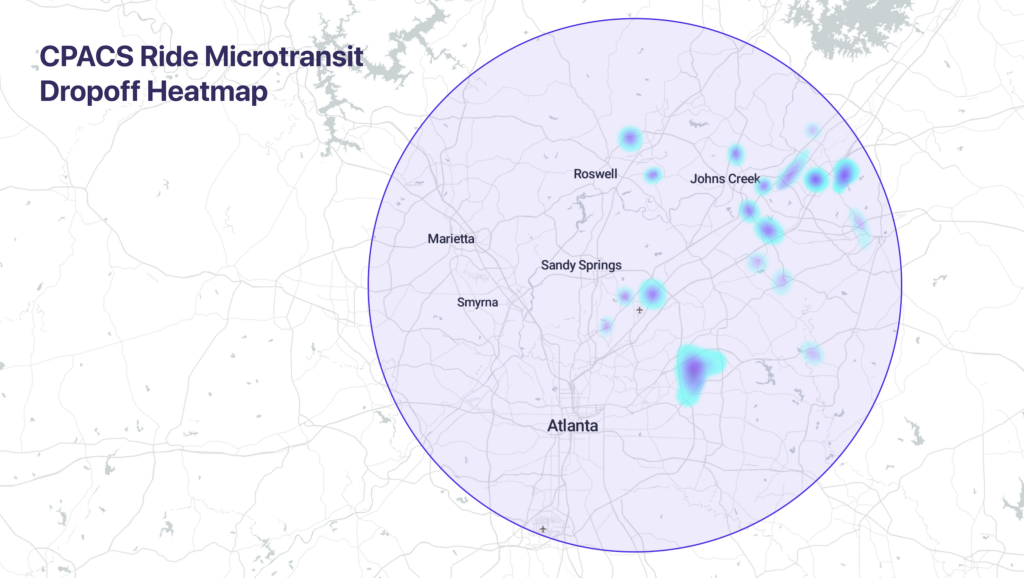
Figure 6- CPACS Trip Destinations from March 1, 2022 – June 30, 2022 representing a total of 2,758 trips. Credit- Spare
To further evaluate the service area, the project team looked at origin and destination trip patterns to help determine where the greatest number of riders travel. The map above shows trip destinations. The origin and destination trip patterns tend to mirror each other given that most of the trips that CPACS provides are two-way. CPACS is using these data to help prioritize its service area and riders it serves by evaluating the impact of isolated longer trips to determine what the opportunity costs are when considering the resources that those trips demand. That is not to say that these longer isolated trips will not occur; they are often for medical appointments or other critical services. However, how and when these trips are scheduled is something CPACS is reviewing along with the opportunity costs considering the time and resources they often demand.
Prior to the start of this project, CPACS Ride’s service area consisted of two-counties extending to Atlanta on the west to parts of Gwinnett County to its north, roughly 500 square miles. Using the origin and destination trip data, a revised service area map was proposed and is currently under evaluation (Figure 6). More discussions are needed to help CPACS determine how to balance serving the greatest number of people versus those with the greatest need that may require long travel distances outside the proposed service area. Note that the high concentration of trips to the Northwest are not included in the proposed service area map. These are work trips and serve more as a fixed route early in the morning and in the afternoon and will continue to be served. The service area also includes several MARTA heavy rail stations and is served by fixed route local bus service that hold the potential to connect individuals to the larger transit network.
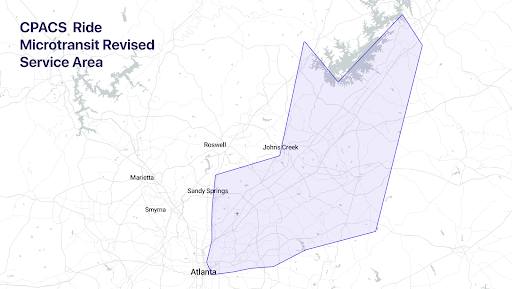
Figure 6 – Revised draft service area map. Credit- Spare
Other solutions that the project team discussed to help alleviate the large service area constraints were to create virtual stops, allow drivers to operate out of their homes in specific zones, and identify trip-sharing opportunities. These different solutions were explored but not implemented.
The last change to help with CPACS Ride’s driver and vehicle shortage was to integrate Transportation Network Companies (TNCs) as an option for their riders. Starting on June 23, CPACS took advantage of the Lyft partnership and promotion with Spare. This allows the scheduling and dispatchers to use Lyft rides as part of their fleet. Riders opt-in to having a Lyft driver rather than CPACS. It is the hope that this pilot will help CPACS see the impact of access to additional vehicles on its operations and capacity issues, especially in situations where there are no other options or it is a long-distance trip. So far, Lyft rides have been used 29 times.
Rider Experience
When procuring a technology solution for fleet and routing optimization, one of the underlying goals is often to increase capacity and increase efficiency. However, if the agency operates a needs-based transportation service specifically for underserved populations with limited transportation options, it is critical to consider the impact of increased efficiencies on the customer experience. How are riders impacted by a given technology solution? This project was confronted with this pain point from the start of implementation.
In this project, prior to implementing technology, CPACS transportation tried to cater to every ride, striving to provide the best rider experience for each of their riders. Beyond just transporting a rider from A to B, CPACS considered the social life of transportation for some people and the dynamic nature of human beings. For example, for two young adults with disabilities, riding together provides the time and space to socialize, so CPACS made sure to pick them up in the same van to provide a good customer experience and support a friendship. As another example, a rider has a recurring medical appointment that CPACS knows takes about 10-15 minutes, and rather than having the rider schedule another ride, the driver often waits for the rider so they are in the same van coming home. After implementing an on-demand software system for dispatching and scheduling, the same personalization and high-touch service could not be matched. The algorithm for efficiency often overruled the needs-based model that originally served them. Furthermore, the riders that felt the biggest impact were older adults or persons with disabilities who have been long-term riders with CPACS, relying on their transportation for everyday needs.
What could help close this gap? From the beginning, Spare explained that the backend settings can be configured to find the balance on the spectrum of efficiency and rider experience. One general example is increasing driver wait time. While the project found specific settings within the platform that did help, the team is still working on finding the balance between moving people with the greatest need versus moving the most people possible. Understanding the settings better from the beginning would have been beneficial. The project team envisions a cheat sheet for combinations of settings for specific outcomes based on the transit agency’s goals. Creating standardized and required simulations would also help test settings before trying them out with riders. Moreover, it is important to understand the software as a service (SaaS) provider’s ability and willingness to customize the operations to fit the needs and goals of the mobility operator.
The transition to using a new on-demand platform has been challenging as CPACS aims to provide a highly customer-oriented experience. Although the Spare platform is not built on rider experience customizability at the level required for CPACS to continue providing culturally competent services, the team continues to explore how settings can be adjusted to balance the use of technology and the rider experience. Below are some settings that have helped the rider experience and resolve some workflow issues. All of these were changed with the goal of improving the rider experience by allowing more flexibility and manual revisions. There is still work to be done balancing the use of technology while maintaining the rider experience but these settings have helped with this transition. Please note, that these are changes that work best for CPACS, but may not be best for every transit agency.
- Detour Flexibility: Refers to the maximum allowed in-trip detour time. A higher flexibility will lead to longer trip durations but a higher rate of pooling overall. With a large service area and a reduced number of vehicles, we set this at 30 minutes for CPACS, which is slightly higher than the average service detour flex.
- Post-Match Flexibilities: After a scheduled request for a rider has been confirmed, the post-match flexibilities allow the request to move the pickup or drop-off time within a flexibility window to help accommodate other ride requests at a similar time. Riders are provided an estimated waiting time at the time of booking to give full transparency of these flexibilities. For CPACS, we set the flexibility window for departure at requests to 25 minutes.
- Driver Wait Time Threshold: This is when drivers are asked to wait after the scheduled pick-up time and before marking the rider as a ‘no show’. We set this for CPACS at 3-minutes to allow for extra time in case the rider needs assistance or runs late. The driver also has the ability to extend this time if required.
- Extra Boarding/Alighting Time: This refers to the extra time allocated for boarding the vehicle with a wheelchair. CPACS set this to 10 minutes, on top of the base boarding time of 2 minutes, to allow additional time for wheelchair riders to board the vehicle safely.
- Trip Editing: This refers to the ability to edit trip times, pickup and drop-off locations, and adjust the number of riders after a trip has been scheduled but before it has started. This setting and the new Spare feature have been very useful for CPACS.
- Service Set Up: This refers to the number of services that an agency creates. CPACS initially created separate services for each community group. This was to pair up riders with drivers who speak the same language. Because CPACS does not have enough drivers, this did not work as planned, since trips were regularly being defaulted to other drivers when the first driver was in use. Once CPACS has more drivers and vehicles, this is something that CPACS plans to explore.
In general, it is important to identify the level of customization your service requires compared to a turnkey solution that can be implemented quickly. It is critical for transportation organizations and agencies to regularly communicate with the technology vendors to share their priorities and represent customer needs. When procuring a SaaS solution, it is important to have these discussions upfront with the technology vendor, ask for demonstrations of their work, and check references. This will, in turn, lead to a more inclusive and customizable design. Spare is engaged in this effort and continues to work with the project team to find the right mix and use of technology.
Next Steps for CPACS
While this grant project officially ends at the end of July 2022, Spare is under contract for an additional year and CPACS hopes to implement the rider-facing app and on-demand service. They would like to take a very slow, phased, and intentional approach to going live to ensure they do not receive an influx of inquiries that they cannot fulfill.

Figure 7 – CPACS Ride rider-facing app
For this reason, the project team discussed going live with CPACS Ride in two phases. Phase 1 is a Usability Study with a small group of riders. A Usability Study is a low-resource way to gain new insights and perspectives on how to improve the app and how to design community engagement activities/training sessions before the app rolls out and goes live with riders. This type of testing requires 15-20 minutes per user. It will be conducted either over Zoom (if Spare can share a high-fidelity prototype or web-based app) or in the CPACS office.
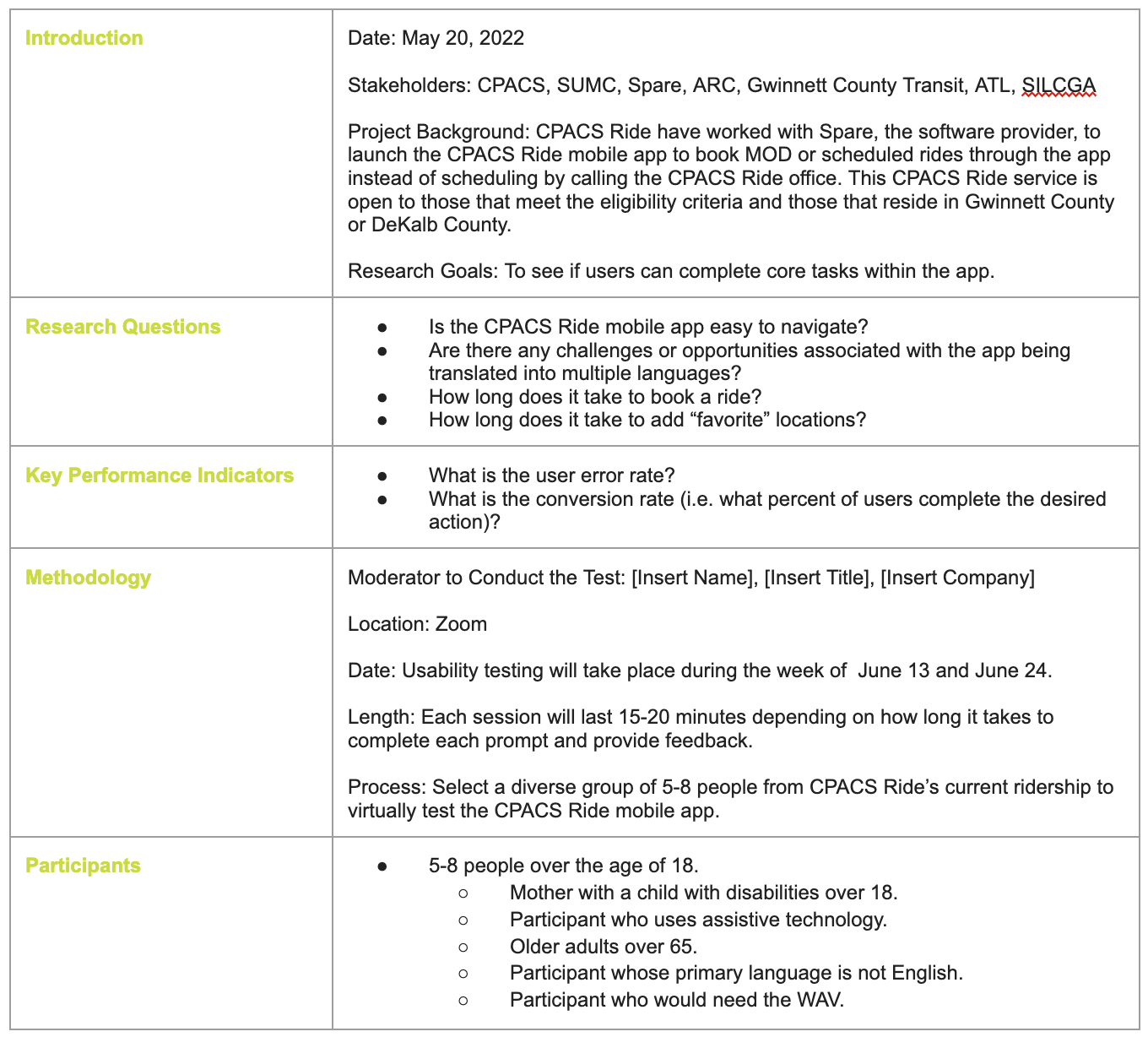
Figure 8 – Sample Usability Study for CPACS Ride
After making any corrections to the app after Phase 1, CPACS could move forward with Phase 2, an opportunity to test it in real-time with a small group of riders (~20 individuals) for a set amount of time. Each rider would be asked to provide feedback and CPACS staff can solidify the workflow before a full launch.
Ultimately, CPACS is committed to serving the critical mobility needs of their communities and hopes to leverage on-demand solutions to meet them. The project team looks forward to following CPACS on their journey to support and offer mobility for all.